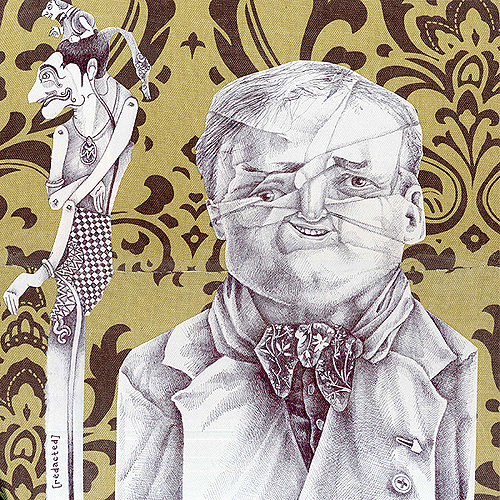Oh no, I didn't make my requisite post on Friday. Well, this one is extra-contenty. Editor's Note: I resolved a text-wrap issue, so the images are now embedded in this post.
I am so excited about this process I want everyone to know about it. I love drawing with ballpoint pens, in particular the Bic Round Stic Medium. (That's the cheapest kind, as it happens.) No other pen gives me the sensitivity and tonal range that I can squeeze out of the Bic. It lets me go from the faintest gray to black without smearing, clumping, or draining my bank account.
So what's the problem? For one thing, this ink is water-soluble, so it's very difficult to employ in the mixed-media processes I use so much. The other, bigger, problem is that this ink is about as far from archival as it can get.
In the last year I made several portrait drawings using the following process:
1. Stretch a canvas in the usual manner. For me, this means a masonite or MDF panel covered with canvas or another heavy duty cloth. Sometimes, I sand a panel and apply several layers of gesso with acrylic mixed in for color.
2. Create a collage from print sources, including photos, magazine pictures, and found paper (text, patterns, etc).

Collage sketch for Normal, OK: Dallas Amarillo
3. Using heavy-duty paper such as Stonehenge, I cut out a rough shape approximating the shape of the collage character. I adhere this paper to the canvas with Golden Acrylic Extra Heavy Matte gel medium. Sometimes I apply some color to the paper shape. I enjoy starting with a rough shape so I can treat it as a set of parameters. Then I draw the character within those (somewhat arbitrary) borders, problem-solving along the way.

Normal, OK: Lawton Amarillo I began this piece with canvas stretched over masonite and primed with gesso and acrylic. The figure is one piece of paper, glued to the canvas, then drawn with Bic ballpoint pen.
So far so good. At this point I could continue with an archival pen such as the Pigma Micron, but I don't like the high-contrast appearance of that ink, especially on smooth surfaces. (I like those pens for drawing directly on unprimed canvas or Stonehenge paper with no gesso or acrylic.)

Normal, OK: Taylor Hutto Taylor is canvas stretched on masonite, lightly primed with tinted gesso. The figure is drawn directly on the canvas with the Pigma Micron 005 pen.
But this is what I did instead:
4. Draw the character (based on the collage-sketch) on the collaged paper using the tasty tasty Bic ballpoint.

Normal, OK: Hinton Geary Upholstery fabric stretched on particle board, collaged paper, figures drawn with Bic ballpoint pen.
5. Hang on a wall for a month, watch as the ink oxidizes and fades.
6. Panic.
Recently I figured a way around this. I can still draw the pen portraits using my trusty Bic. I take the finished drawing and photocopy it or scan it and make a laser print. Then I make an acrylic gel transfer.
Tomorrow I'll describe the transfer process.